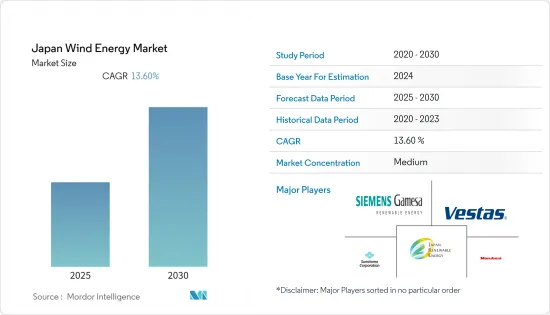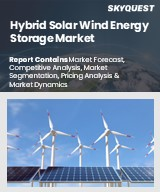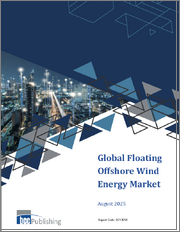
|
시장보고서
상품코드
1685947
일본의 풍력에너지 : 시장 점유율 분석, 산업 동향 및 통계, 성장 예측(2025-2030년)Japan Wind Energy - Market Share Analysis, Industry Trends & Statistics, Growth Forecasts (2025 - 2030) |
||||||
■ 보고서에 따라 최신 정보로 업데이트하여 보내드립니다. 배송일정은 문의해 주시기 바랍니다.
일본의 풍력에너지 시장은 예측기간 동안 CAGR 13.6%로 성장할 전망입니다.

주요 하이라이트
- 장기적으로 정부 정책, 향후 풍력 발전 프로젝트에 대한 투자 증가, 풍력 에너지 비용 감소와 같은 요인이 시장을 주도할 것으로 예상되며, 이는 풍력 에너지 채택 증가로 이어졌습니다.
- 한편, 가스 기반 전력 및 태양열과 같은 대체 에너지원의 채택이 증가함에 따라 시장 성장을 저해할 가능성이 높습니다.
- 하지만 국내 전력 수요 증가는 조만간 풍력 발전 시장 기회를 제공할 것으로 예상됩니다. 막대한 풍력 발전 잠재력과 풍력 에너지 비용의 하락은 향후 몇 년 동안 시장에 광범위한 비즈니스 기회를 제공 할 것으로 예상됩니다.
일본의 풍력에너지 시장 동향
육상 부문이 시장을 지배 할 전망
- 육상 풍력 에너지는 예측 기간 동안 시장을 지배 할 것으로 예상됩니다.
- 2022년의 연간 신규 도입량은 149MW로, 이 나라의 육상 풍력에너지 설비 용량은 2021년의 4523MW로부터 2022년에는 4668MW로 증가하여 일본 내 육상 풍력 에너지 시장을 주도할 것으로 예상됩니다.
- 일본 경제산업성(METI)에 따르면 2024 회계연도 육상 풍력 전력의 발전차액지원제도(FIT) 매입 가격은 킬로와트시당 14엔으로 책정되었습니다.
- 세계풍력에너지회의(GWEC)에 의하면, 2022년 시점에서 국내의 총설비 풍력발전용량은 480만kW에 달하며, 신규 설비용량의 대부분은 육상 풍력 발전 설비에서 발생했습니다
- 경제산업성은 2022년 11월, 보다 폭넓은 사업자와 신속한 인프라 구축을 촉진하기 위해 업데이트된 기준에 따라 2022년 12월부터 해상 풍력 발전 프로젝트에 대한 공개 경매를 시작할 계획이라고 발표했습니다.
- 게다가 일본 정부는 2023년 5월, 4,000만 kW의 육상 윈드 팜을 설치하는 목표를 발표했습니다. 또한 2023년 2분기에 시운전될 것으로 예상됩니다.
- 따라서 기존의 육상 풍력 에너지 용량과 예정된 프로젝트로 인해 이 부문은 예측 기간 동안 지배적일 것으로 예상됩니다.
시장을 견인하는 정부 정책과 투자 확대
- 우호적인 정부 정책이 일본의 풍력 에너지 시장을 견인할 것입니다.
- 또한 정부는 2035년까지 LCOE8-9엔/kWh를 달성하고 2040년까지 누적 용량 30-45GW를를 달성하기 위한 공급망 개발 및 비용 절감 경로를 계획하고 있습니다.
- Energy Institute Statistical Review of World Energy 2023에 따르면, 2022년의 풍력에 의한 발전량은 8.2TWh이며, 2020년의 7.8TWh로부터 증가하고 있습니다.
- 일본의 풍력 에너지 부문은 청정 에너지원으로의 전환을 위한 정부의 노력과 재생 기술의 지속적인 발전으로 인해 가까운 미래에 성장할 것으로 예상됩니다.
- 게다가 일본이 2040년까지 세계 제3위의 해상 풍력 발전 기지를 건설하는 것을 목표로 하고 있기 때문에 유럽의 일부 에너지 기업이 일본에 투자하고 있습니다. 또한 정부는 1조 7,000억엔(159억 달러)의 민간 투자를 자극하는 세제 우대 조치를 제공할 예정입니다.
- 게다가 2022년 9월에는 미국 제너럴 일렉트릭사의 풍력 터빈 제조 부문인 GE 리뉴어블 에너지사와 그린 파워 인베스트먼트사가 공동으로 일본의 육상 풍력 발전소 을 개발했습니다. 이 풍력발전소는 니시쓰가루군 후카우라초에 위치해, 설치 용량은 79.8MW입니다.
- 따라서 정부의 지원과 재생 에너지에 대한 투자 증가가 예측 기간 동안 풍력 에너지 시장 성장을 주도할 것으로 예상됩니다.
일본의 풍력에너지 산업 개요
일본의 풍력에너지 시장은 통합되어 있습니다. 시장의 주요 기업(특별한 순서 없음)에는 Vestas, Siemens Gamesa Renewable Energy, Sumitomo Corporation, Marubeni Corporation 및 Japan Renewable Energy Co. Ltd.가 포함됩니다.
기타 혜택
- 엑셀 형식 시장 예측(ME) 시트
- 3개월의 애널리스트 지원
목차
제1장 서론
- 조사 범위
- 시장의 정의
- 조사의 전제
제2장 주요 요약
제3장 조사 방법
제4장 시장 개요
- 소개
- 풍력에너지의 설치 용량 및 예측(-2028년)
- 최근 동향과 개발
- 정부의 규제와 정책
- 시장 역학
- 성장 촉진요인
- 향후 풍력 발전 프로젝트에 대한 투자 증가
- 유리한 정부 정책
- 억제요인
- 가스 기반 전력과 같은 대체 에너지원의 채택 증가
- 성장 촉진요인
- 공급망 분석
- PESTLE 분석
제5장 시장 세분화
- 전개 장소
- 육상
- 해외
제6장 경쟁 구도
- M&A, 합작사업, 제휴, 협정
- 주요 기업의 전략
- 기업 프로파일
- Vestas AS
- Siemens Gamesa Renewable Energy
- Japan Renewable Energy Co. Ltd
- Marubeni Corporation
- Sumitomo Corporation
- Eurus Energy Holdings Corporation
- Synera Renewable Energy Co., Ltd.
제7장 시장 기회와 앞으로의 동향
- 일본의 해상 풍력 발전 분야의 진전
The Japan Wind Energy Market is expected to register a CAGR of 13.6% during the forecast period.

Key Highlights
- Over the long term, factors like government policies, the increasing investment in upcoming wind power projects, and the reduced cost of wind energy, are expected to drive the market. which has led to increased adoption of wind energy
- On the other hand, The growing adoption of alternative energy sources such as gas-based power and solar power will likely hinder the market growth.
- Nevertheless, Increased demand for electricity in the country is expected to provide market opportunities for wind power development shortly. The massive wind power potential and a decline in the cost of wind energy are expected to provide widespread business opportunities to the market in the coming years.
- Favorable government policies and increasing investments in the offshore wind energy sector are expected to drive the market during the forecast period.
Japan Wind Energy Market Trends
Onshore Segment is Expected to Dominate the Market
- Onshore wind energy is expected to dominate the market during the forecast period. Wind energy has become a major source of support for Japan to reach its net-zero target and decarbonize its heavy industries, such as steel manufacturing and shipping.
- With a new annual installation of 149 MW in 2022, onshore wind energy installed capacity in the country reached 4668 MW in 2022, up from 4523 MW in 2021, driving the onshore wind energy market in the country.
- According to the Ministry of Economy, Trade and Industry (METI), for the fiscal year 2024, the FIT (feed-in tariff (FIT)) purchase price for onshore wind electricity was set at JPY 14 per kilowatt hour. The price has decreased continuously throughout the past decade.
- As of 2022, the country's total installed wind capacity reached 4.8 GW, according to the Global Wind Energy Council (GWEC), and the majority of the new capacity came from onshore wind installations. It is further expected to grow during the forecast period, as several wind power projects are planned in Japan.
- In November 2022, the Ministry of Economy, Trade, and Industry announced plans to begin public auctions for offshore wind generating projects in December 2022 under updated criteria to promote a broader range of operators and speed infrastructure construction. The auction is planned to cover four sites with a combined capacity of 1.8 GWs.
- Moreover, in May 2023, the Government of Japan announced its aim to install 40 GW of onshore wind farms. Also, it is expected to be commissioned in Q2 2023. The Dohoku wind farm cluster, a 339.7 MW wind farm cluster, consists of four projects located on the island of Hokkaido. The complex consists of 79 units of wind turbines.
- Hence, with existing onshore wind energy capacity and upcoming projects, the segment is expected to dominate during the forecast period.
Government Policies and Increasing Investments to Drive the Market
- .Favorable government policies will drive the wind energy market in Japan. The government has launched various government policies and initiatives to support the growth of renewable energy and wind energy deployment in the country. For instance, the Japanese government unveiled its Offshore Wind Industry Vision. This vision outlines a plan to allocate 1 GW of offshore wind capacity annually through 2030.
- Additionally, the government has plans for supply chain development and cost reduction pathways to reach JPY 8-9/kWh of LCOE by 2035 and 30-45 GW of cumulative capacity by 2040.
- According to the Energy Institute Statistical Review of World Energy 2023, electricity generated from wind was 8.2 TWh in 2022, which was increased from 7.8 TWh in 2020. Also, according to the Asia Wind Energy Association, Japan has an estimated wind energy potential of 144 GW for onshore wind and 608 GW of offshore wind capacity.
- Japan's wind energy sector is expected to grow in the near future, owing to government initiatives to transition to cleaner energy sources and continual advancements in renewable technologies. In recent years, the country has established various climate goals in order to reach carbon neutrality.
- Moreover, Several European energy companies are investing in Japan as the country aims to create the world's third-largest offshore wind power fleet by 2040. Further, the government is expected to provide tax incentives to stimulate JPY 1.7 trillion (USD 15.9 billion) in private investment. Such initiatives are expected to have a positive impact on the market studied.
- Furthermore, in September 2022, GE Renewable Energy, an American wind turbine manufacturer division of General Electric, and Green Power Investment collaborated to develop an onshore wind farm in Japan. The wind farm is located in FukauraTown, Nishi Tsugaru District, with an installed capacity of 79.8 MW. As a part of the collaboration, GE will supply 19 units of GE's 4.2-117 onshore wind turbines to the power plant.
- Hence, government support and rising investments in renewable energy are expected to drive the wind energy market growth during the forecast period.
Japan Wind Energy Industry Overview
The Japan wind energy market is consolidated. Some of the key players in the market (in no particular order) include Vestas, Siemens Gamesa Renewable Energy, Sumitomo Corporation, Marubeni Corporation, and Japan Renewable Energy Co. Ltd.
Additional Benefits:
- The market estimate (ME) sheet in Excel format
- 3 months of analyst support
TABLE OF CONTENTS
1 INTRODUCTION
- 1.1 Scope of the Study
- 1.2 Market Definition
- 1.3 Study Assumptions
2 EXECUTIVE SUMMARY
3 RESEARCH METHODOLOGY
4 MARKET OVERVIEW
- 4.1 Introduction
- 4.2 Wind Energy Installed Capacity and Forecast in GW, till 2028
- 4.3 Recent Trends and Developments
- 4.4 Government Policies and Regulations
- 4.5 Market Dynamics
- 4.5.1 Drivers
- 4.5.1.1 Increasing Investment in Upcoming Wind Power Projects
- 4.5.1.2 Favorable Government Policies
- 4.5.2 Restraints
- 4.5.2.1 The Growing Adoption of Alternative Energy Sources Such as Gas-Based Power
- 4.5.1 Drivers
- 4.6 Supply Chain Analysis
- 4.7 PESTLE Analysis
5 MARKET SEGMENTATION
- 5.1 Location of Deployment
- 5.1.1 Onshore
- 5.1.2 Offshore
6 COMPETITIVE LANDSCAPE
- 6.1 Mergers and Acquisitions, Joint Ventures, Collaborations, and Agreements
- 6.2 Strategies Adopted by Leading Players
- 6.3 Company Profiles
- 6.3.1 Vestas AS
- 6.3.2 Siemens Gamesa Renewable Energy
- 6.3.3 Japan Renewable Energy Co. Ltd
- 6.3.4 Marubeni Corporation
- 6.3.5 Sumitomo Corporation
- 6.3.6 Eurus Energy Holdings Corporation
- 6.3.7 Synera Renewable Energy Co., Ltd.
7 MARKET OPPORTUNITIES AND FUTURE TRENDS
- 7.1 Progress In Japan's Offshore Wind Power Sector
샘플 요청 목록



















